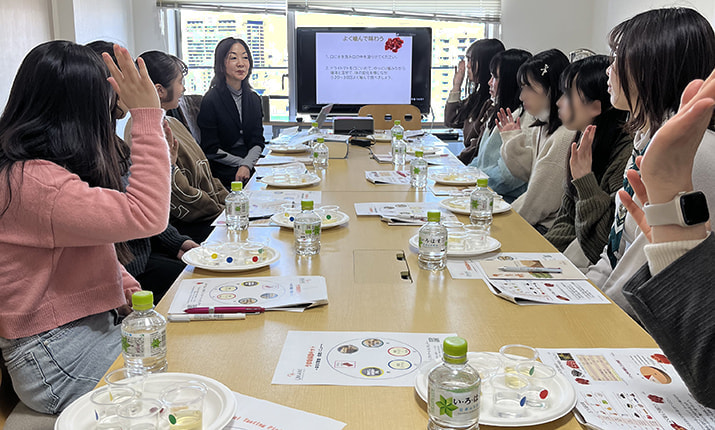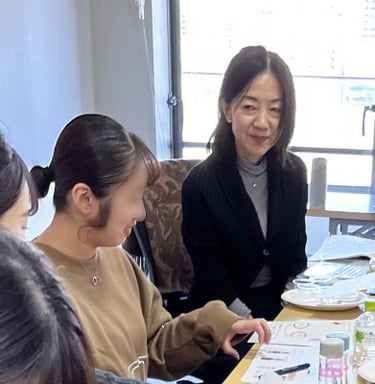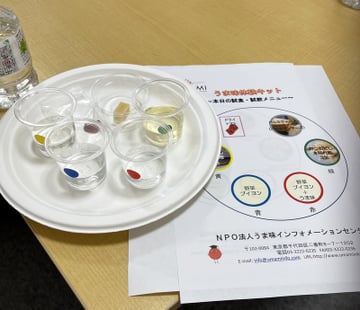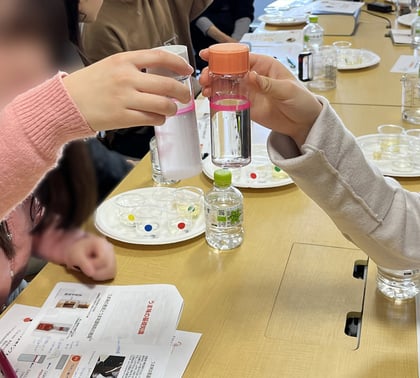The Exercise of Food Science “Knowing Umami, Feeling Umami” to Otsuma Women's University
March 2024

Eight students from Otsuma Women's University visited the Umami Information Center (UIC) with Professor Miho Otahara on March 21, 2024. They were third-year students studying food science at the university, and they took a food science seminar titled "Knowing Umami, Feeling Umami" taught by UIC director Yasue Kido as a regular class at the university.
To match the students, who had acquired sufficient knowledge of nutritional science over three years, Ms. Kido tailored her lecture making it more advanced and practical than the regular ones.
For example, she added introduction of the UIC's official website. https://www.umamiinfo.com/
UIC's official website and YouTube channel contain a lot of useful information for those involved in food and health work activities.

There are useful contents such as the “Umami Database,” which helps them research how much umami substances are contained in foods, https://www.umamiinfo.com/umamidb/ and “Local Cuisine in Japan and Umami,” which introduces local dishes from the umami point of view.
https://www.umamiinfo.com/japaneseumami2/localcuisine/
Ms. Kido actually made use of a 3-minute YouTube video, “Umami Basics,” which compactly summarizes basic information on umami substances. https://www.youtube.com/watch?v=9mUCCj3YYlg
She also showed the students that “umami” is listed in Kojien (the most trusted dictionary in Japan) and that the Japanese word umami is a homonym for both umami and deliciousness. She made them aware of the correct knowledge of the relationship between deliciousness and umami.

She encouraged the students to taste several kinds of dashi and umami ingredients, keeping attention to the three characteristics of umami: “spread over the entire tongue,” “persistence,” and “promote salivation,” so that they would be able to recognize umami through experience as well as through classroom knowledge.
The lecture also included an experiment in dissolving monosodium glutamate (MSG).
Many umami seasonings contain MSG as their main ingredient. The reason for this is that glutamate is not soluble in water on its own, but when it is converted into the sodium salt form, MSG, it becomes more soluble in water and easier to use in cooking. To confirm this property, students conducted an experiment in which they added both glutamate and MSG to water respectively and compared the dissolution of the two substances.

In the second half of the lecture, Ms. Kido explained the difference between free amino acids and proteins, as well as the role that umami plays in health. The health benefits of umami include the effect of maintaining the taste of dishes even when salt content is reduced, and the rehabilitation for people with taste disorders using its property of promoting salivation. All of these are knowledge that should be known to those who are considering working in food and health works.
The students participated in the class with great enthusiasm. The followings are some of the comments received after the lecture.
“I observed that MSG dissolves quickly in water, and I now understand why sodium salts are used in seasonings.”
“I would like to make a salt-reduced meal using umami in the nursery school lunch program.”
“It was good to know the relationship between taste disorder and umami. It could be a hint for tasty hospital food.”
“When I was traveling abroad, I couldn't wait to return home and eat udon noodles in dashi soup. Now I realized that I wanted to taste umami at that time.”
We hope that the participating students will apply their new knowledge to the next stage of their careers. We also hope that they will share their knowledge with their families and people around them so that everyone can make good use of umami to lead a healthy life.
